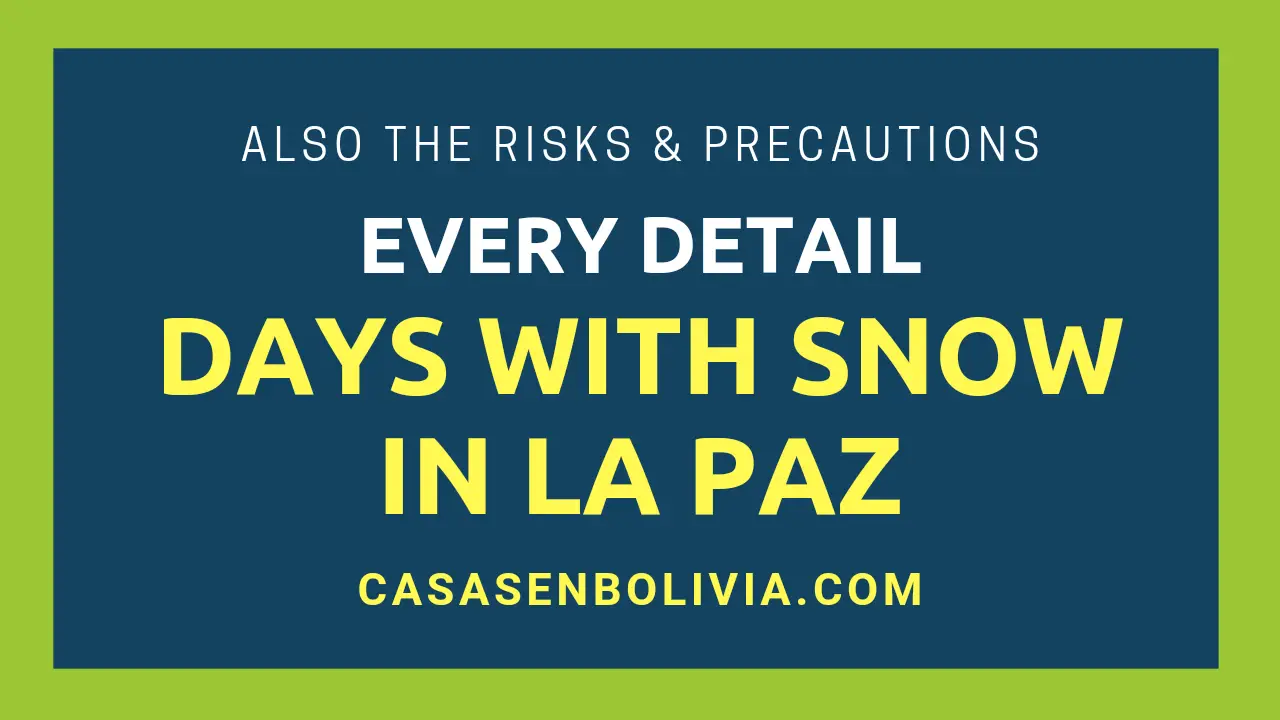Last Updated on February 15, 2025
Snowfall in La Paz, Bolivia, isn’t a frequent occurrence throughout the year. Although it’s a cold city situated near the Andes Mountains, seeing snow fall from the sky is relatively uncommon, except during the winter season.
La Paz typically experiences snow on 3 to 10 days throughout the year. These days are concentrated in the winter season (from May 21st to August 20th) and are more frequent in June and July. Expect 3 to 5 inches of snow per event. Hail is also common in La Paz, but it primarily occurs during the summer.
In this article, we’ll discuss the average number of snowy days in La Paz, Bolivia, within a given year, as well as the frequency of snowfall in different months and during the winter. Additionally, you’ll learn about hail in La Paz and its potential dangers. We are Bolivian citizens.
The Average Number of Days with Snowfall in La Paz
It’s typical for La Paz, Bolivia, to experience snowfall *between 3 and 10 days throughout the year*. These days are concentrated in the winter, between June and July, although snowfall can occasionally occur in May or August.
The amount of snow you’ll experience on these days is minimal in the city, with perhaps around 3 inches of accumulation per event. Snowfall typically lasts for 1 to 3 hours before ceasing.
Furthermore, snowfall commonly occurs during the night, between 1:00 a.m. and 6:00 a.m. in most cases. Therefore, when you wake up on these winter days, you’ll likely find a layer of snow outside.
Snow in El Alto City
It’s also worth noting that El Alto (which is very close to La Paz and houses La Paz’s international airport) experiences significantly more snowfall. On average, El Alto sees between 10 and 20 days of snowfall, primarily during winter, and many mornings between June and July are greeted with around 5 inches of snow.
The Time of Year with the Most Snowfall in La Paz
As mentioned earlier, most of these snowy days occur between June and July each year. These two months correspond to the end of fall and the beginning of winter. Snowfall in other months is rare, but possible.
The frequency of snowfall in La Paz is as follows:
- Between 3 and 5 days in June and July.
- Between 1 and 2 days in May.
- Occasionally, 1 day in August.
- Very rare from September to March.
Hail is Also Common in La Paz
Snow is one aspect of La Paz’s climate, but hail is also a significant factor. Unlike snow, hail can occur more frequently throughout the year. Also, unlike snow, hail can pose significant dangers to the city of La Paz.
When hail occurs in La Paz, it often falls heavily. Hail is more frequent during the following times of the year:
Summer
From December to March. During this period, hail can be very intense, appear suddenly, last between one and two hours, and involve accumulations of 10 to 50 inches. The frequency is typically between two and five days of hail during these three months.
Hail can be dangerous in La Paz during the summer. It can cause traffic problems, block the city’s drainage systems, and transform the main streets and avenues into powerful rivers. In fact, 20 years ago, a climate catastrophe occurred due to hail, as you can see in the following article (Translated: Link). This event even resulted in loss of life due to the massive hail that day.
A catastrophe like that is highly unlikely today because the city has been modernized and its drainage systems have been upgraded to prevent a recurrence. However, when hail occurs between January and March in the city, you should still exercise considerable caution.
If you find yourself in a severe hail event or hailstorm in La Paz, Bolivia, during this time, seek shelter in a covered, *elevated location*, perhaps inside a building, *as quickly as possible* to protect yourself.
Winter
From June to August. Hail can also occur in winter, but it’s less likely. Hail during this season *is typically very light*, and in many cases, it’s mixed with snow. Therefore, you usually won’t encounter significant problems with winter hail in La Paz, Bolivia.
It’s also worth noting that hail is much more frequent in El Alto than in La Paz, both in summer and winter. However, it shouldn’t pose major problems beyond snow in this city. Why? Because El Alto is situated on flat land, preventing the formation of strong rivers and limiting the impact to flooding at most.
Conclusions:
In this article, you’ve learned about the frequency of snowfall in La Paz, Bolivia, which ranges from 3 to 10 days throughout the year. You’ve also seen that these days are primarily concentrated in the winter, spanning from May to August, with a higher frequency in June and July.
You’ve also learned that snowfall events typically result in 3 to 5 inches of accumulation and that they mostly occur during the night. Additionally, El Alto, a major city adjacent to La Paz, experiences significantly more snowfall, between 10 and 20 days, also more frequently during the winter.
Finally, you’ve seen that hail is also common in La Paz and can be dangerous. Severe hail occurs in the summer, between December and March, almost every year. When caught in a hailstorm in La Paz, you should seek shelter in a highly elevated and covered location or building as quickly as possible.
We hope this information has been helpful. If you’d like to learn every detail about the climate in Bolivia, including snowfall in other principal locations, please visit our definitive guide here: How is the climate in Bolivia? A complete overview.
CasasenBolivia.com, information on living, working, investing, and traveling in Bolivia.








